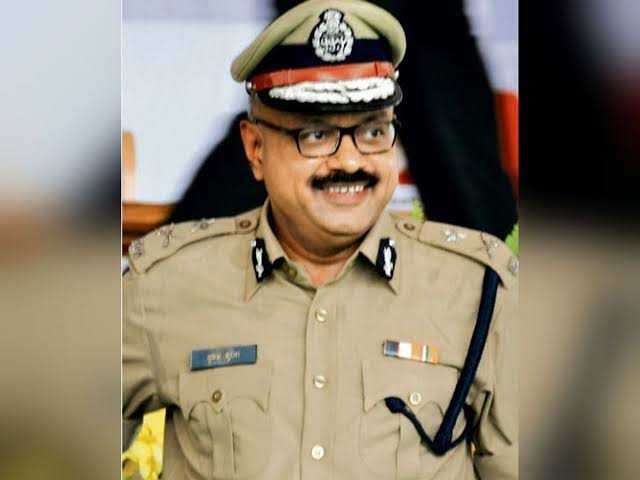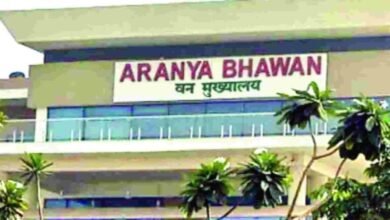Former IG Mukesh Gupta held responsible for Madanwada Naxal encounter that claimed then SP Choubey

Raipur: The report of the Special Investigation Commission on the Madanwada Naxal encounter was presented in the Chhattisgarh Legislative Assembly on Wednesday. The chairman of the commission, Justice S M Shrivastava, held the then Inspector General of Police (IG) Mukesh Gupta responsible for the incident and believed that the IG acted against the defined rules in the battlefield. Not only this, martyred SP Choubey ordered was ordered to proceed without any protective cover, and he remained locked in an anti-land mine vehicle or in his own car, the investigation report found.
Chief Minister Bhupesh Baghel presented the report of the judicial inquiry commission constituted on the Madanwada Naxal encounter in the assembly on Wednesday. The commission was constituted headed by Justice Shrivastava. As many as 29 police personnel including the SP were martyred in the incident took place on 12 July 2009. The commission has made a strong comment questioning the role of the then IG Mukesh Gupta.
The report said that this incident was the result of arrogance, which provided leadership in a stigmatized, sloppy and irresponsible manner. No Naxalites were injured in the encounter. This is the carelessness, shortcomings and laziness of IG Gupta, who was the Commander-in-Chief. It has been said in the investigation report that the IG shouted and forced the SP to move forward, if it was not done then the life of the SP could have been saved.
Justice Shrivastava presented his report after carefully assessing the statements of the policemen present at the spot, in which he found that IG Gupta was clearly aware that Naxalites had taken their positions in large numbers and they hiding in the forest, and they are firing from both sides of the road. In such circumstances, instead of giving strength to the force from behind so that it moves forward, they had to take the help of CRPF and STF. Commanders and superiors on duty are required to ensure that they do not act in such a way as to put their subordinates in dangerous situations.
The commission observed that police camps were set up in Madanwada without due procedures and without the approval of the state government and despite intelligence reports from the SIB. There was no watchtower in that camp, no infrastructure. There was no arrangement for the policemen to stay there. There was no toilet for the CAF employees of Madanwada.
The commission considered the presence of IG Mukesh Gupta at the spot suspicious. On the other hand, SI Kiritram Sinha and the driver of Anti Land Mine Vehicle Kedarnath were quoted as saying that they were present near the Naka barrier at some distance on the day of the accident. Even if they had come to the spot, they would have come very late, when the CRPF had reached. The story of staying at the scene and firing on the Naxalites is a story composed by him. It is also necessary to note here that the whole story was made up, and was composed, that is why the case ended after the court acquitted everyone.
The investigation report also mentions the statement of this then ADG Naxal Operation Girdhari Nayak. Nayak has said that the then IG Mukesh Gupta did not follow the rules of the war zone, due to which 25 policemen were martyred on the spot. Nayak has also clarified in his statement that he did not recommend out-of-turn promotion to IG Mukesh Gupta in his investigation report. While he had advised that when not a single Naxalite was killed, not a single weapon was found, the police personnel should not be rewarded.
All possible action should be taken to strengthen the local intelligence system. It is possible to prevent incidents and do counter planning accordingly if information regarding Maoist activities in the area is received in advance. If necessary, special training programmes should be run to make the information system effective.
Every information/intelligence in the field should be analyzed closely and a strong and reliable information system should be developed in the internal areas. In some incidents, due to not taking the small information seriously, many times unpleasant situation is happened.
Nodal officer should be appointed in the district, by whom the intelligence received from IB / SIB and other sources should be collected, collate and analysis should be reported to the senior officers and based on this, the operation should be done. Plans should be prepared for Ambush, Counter Ambush etc.
All jawans/officers posted in Naxal affected areas must be trained in jungle warfare and practiced in plain areas etc. Regular refresher courses should be conducted from time to time for officers/soldiers. .
The guerrilla tactic of the Maoists is that “when the enemy advances, retreat, when the enemy starts returning, chase – disturb, when the enemy gets tired then suddenly attack”. Before each operation, a detailed briefing should be done to all the jawans regarding the said tactics of the Maoists and its counter tactics.
By the Naxalites doing any incident in the area or by sending some kind of false information, an attempt is made to trap the police party, for which various methods are adopted by the Naxalites. During the reaction movement of the security forces, they are ambushed by the Naxalites. In view of the above, necessary action/planning should be done.
Routine and informal movement of security forces should not be done at all. All movements should be done with proper planning and proper supervision like ops. Complete secrecy should be maintained regarding the movement of security forces.
Road movements of security forces are most sensitive. Extreme caution/care should be taken especially during safety duty in ROP/RSO and road construction. Strategic heights should also be designated on both sides of the road for ROP and special care should be taken at the ambush site. These things should be included at the planning stage itself.
Avoiding the use of vehicles on Naxal-affected interior routes as far as possible. If absolutely necessary, the road and the surrounding area should be effectively dominated and de-mined, the movement should be done only.
Planning of Ops by thorough analysis of intelligence received in the presence of senior officers and ops commanders of the forces involved, past incidents in the area, active Naxal formations, their capability, geographical location of the area, local population etc. before each operation. be done Ops should not be planned in haste or haste.
The security forces should be provided with arms, ammunition, area weapons, state-of-the-art communication tools like wireless sets, satellite phones, tracking equipment like GPS trackers and other important equipment like binoculars/night vision etc.
State-of-the-art equipment such as drones etc. should be made available to the security forces for state-of-the-art counter surveillance. On special occasions, the help of UAVs should be taken to keep a watch on the Naxalites.
The wireless set must be digitized and encrypted so that the Maoists cannot track the activities of the security forces.
Before going to the campaign, it should be ensured that adequate first aid kit and adequate nursing staff are available in each team.
Before launching the Ops, a detailed briefing should be done to all the jawans, under which the briefing includes the geographical location, climate and sensitivity of the area, Naxal formations active in the area, their strength, fire power, past incidents in the area, IED/ Information should be given about ambush pits, Naxal allies, hostile villages, blind bends, valleys, bridges, culverts, possibility of Naxal attacks, possibility of Naxalites to plant IEDs, etc.
Preparation and rehearsal should be done from time to time to deal with the emergency situation. Which will help in reacting in a coordinated and effective manner.
In Naxal-affected areas, the jawans should be specially trained in fire control because sometimes encounters with Naxalites force the security forces to stay in the field for a long time and re-enforcement takes time. Taking advantage of this situation, Naxalites do repeat attacks. Therefore, fire control is very important in the event of an encounter.
In the operation planning, a plan should also be made to block the escape route of the Maoists.
De-briefing should be done after the completion of the ops, in which the positive and negative facts of the security forces during the ops should be included. Also, special attention should be paid to the above points in the briefing before re-launching the ops in the said area.
Planning and action should be taken during the campaign after assessing each contingency situation. The availability of adequate reserve force for contingency in the nearest police stations/camps should be ensured and kept in alert state so that re-enforcement can be sent to the party in time, if required.
A detailed analysis of the Maoist incidents in the area should be done and a case study should be prepared, in which the do’s and don’ts for the security forces should be included. Share this with everyone.
In the event of a Naxalite incident, after adequately assessing the geographical location of the area and the sensitivity of the area, after assessing each aspect accurately, one should leave with full preparation in a planned manner, in no case should be hasty.
In case of any Ambush/Naxal incident, proper planning and operation should be carried out in a coordinated manner. For example, in the event of an ambush, keeping in mind the position of the Naxalites, target and siege action should be taken.
On the occurrence of any incident, it is more useful from a tactical point of view to get proper response/action by keeping in mind the various aspects by monitoring the incident and situation itself, rather than going by the senior officers immediately.
Establishment of new police camps is necessary for carrying out effective operation against Naxalites in intensive Naxal affected area and from operational point of view. At present, there are new security bays in the Naxalite core areas.
During Routine ops, care should be taken that no pattern is established. Every routine ops should be closely supervised by senior officers.
From time to time, ROP/RSO/Mobile Check Post (MCP) duty by the security forces should be done to secure the main and link roads, as well as area domination, searching and patrolling in the surrounding areas.
Ambushing action should be taken by marking the possible access routes of Maoists.
Action should be taken in the Naxal affected areas under the Triveni action plan of the State Government of “Trust-Vikas-Security”. Under which necessary action should be taken to provide employment opportunities to the youth of Naxal affected areas under central armed schemes to gain the trust of the people of Naxal affected areas and to speed up development and employment oriented works. This can also strengthen the intelligence system.
Action should be taken to establish development works like roads, bridges/culverts, mobile towers in the area.
New security camps should be set up to provide strategic advance in the areas without security and to provide security to the general public residing in the interior areas.
In order to provide basic facilities to the villagers residing in the inner villages, action should be taken to establish Integrated Development Centers in coordination with the district administration.
Meaningful action should be taken to conduct community policing programs so that the trust of the people of the area can be gained.
Necessary cooperation, security and all possible assistance should be provided to the residents of the area by the police forces under “credible policing”.





